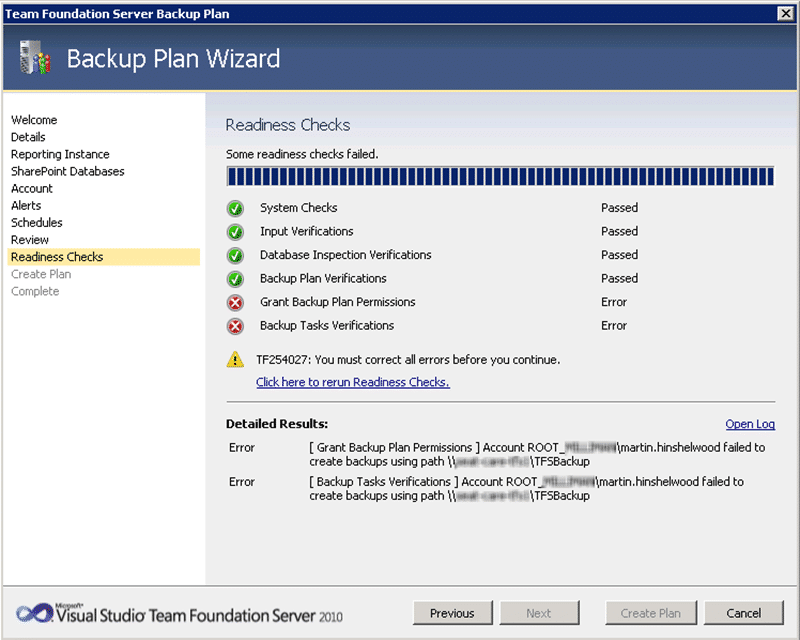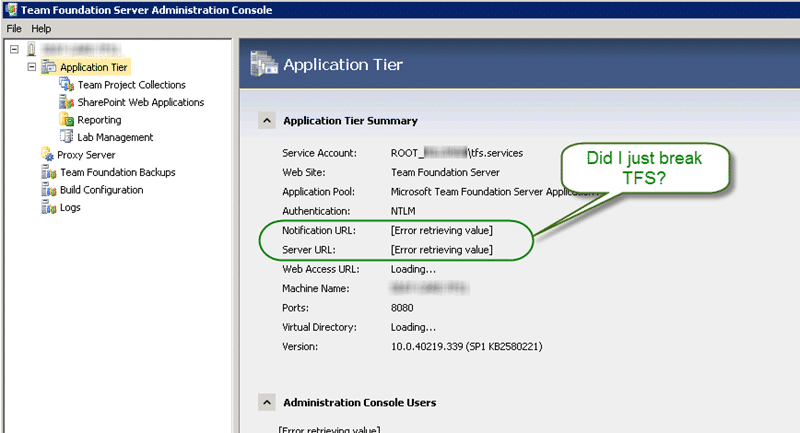TF200035 Sync error for identity with TFS 2010
Details troubleshooting a TF200035 sync error in TFS 2010, covering Active Directory issues, machine account permissions, domain compatibility, and …
TL;DR; Step-by-step guide to backing up Team Foundation Server 2010 with Power Tools, including required permissions, common errors, and troubleshooting backup issues.


Over the last few years the product team has been putting their finishing touches on a backup module for the Team Foundation Server Administration Console. Why you might ask do you need another way to backup? Surely you can just backup the bits?
Well, you could, but as TFS has a lot of moving parts it can get very complicated to creating a backup .
- Required Permissions
- Identify Databases
- Create Tables in Databases
- Create a Stored Procedure for Marking Tables
- Create a Stored Procedure for Marking All Tables At Once
- Create a Stored Procedure to Automatically Mark Tables
- Create a Scheduled Job to Run the Table-Marking Procedure
- Create a Maintenance Plan For Full Backups
- Create a Maintenance Plan For Differential Backups
- Create a Maintenance Plan For Transaction Backups
- Back Up Additional Lab Management Components
-From “Back Up Team Foundation Server” on MSDN
There are a heck of a lot of databases that, depending on your environment, might be spread over your entire network.
 Figure: Deployment Topologies (Where is my data?) from MSDN
Figure: Deployment Topologies (Where is my data?) from MSDN
So, how is this problem solved. Well the TFS team have create a tool to create all of the backups and all of the job as well as managing the backup location for you. This sounds fantastic, but how about in practice.
[screencast url=“ http://www.screencast.com/t/PaBBcWZXn" width=“640” height=“360”]
Screencast: Administering TFS 2010: Team Foundation Backup
Was it really that easy? Well….not really…here is the extra stuff I found out:
Once you learn how to Google without keywords and read your servers mind you will have a nice backup system going…
I initially got an error because the accounts did not really have full control over the target location. This is a problem with the share. Although I have full permission for fileserver1ShareTFSBackups it is just a folder under the [fileserver1Share](file://fileserver1folder” data-mce-href=) location and I DO NOT have permission to change the sharing settings there.
 Figure: TF254027 is caused by permission issues
Figure: TF254027 is caused by permission issues
1[Info @16:36:34.342] Granting account ROOT_COMPANYtfssqlbox$ permission on folder <a href="file://fileserver1folderTFSBackups[Info">fileserver1ShareTFSBackups [Info</a> @16:36:34.348] System.UnauthorizedAccessException: Attempted to perform an unauthorized operation.
2 at System.Security.AccessControl.Win32.SetSecurityInfo(ResourceType type, String name, SafeHandle handle, SecurityInfos securityInformation, SecurityIdentifier owner, SecurityIdentifier group, GenericAcl sacl, GenericAcl dacl)
3 at System.Security.AccessControl.NativeObjectSecurity.Persist(String name, SafeHandle handle, AccessControlSections includeSections, Object exceptionContext)
4 at System.Security.AccessControl.FileSystemSecurity.Persist(String fullPath)
5 at Microsoft.TeamFoundation.PowerTools.Admin.Helpers.FileHelper.GrantFolderPermission(String account, String path)
6[Info @16:36:34.350] Granting account ROOT_COMPANYtfs.services permission on folder <a href="file://fileserver1TFSBackups[Info">fileserver1ShareTFSBackups [Info</a> @16:36:34.352] System.UnauthorizedAccessException: Attempted to perform an unauthorized operation.
7 at System.Security.AccessControl.Win32.SetSecurityInfo(ResourceType type, String name, SafeHandle handle, SecurityInfos securityInformation, SecurityIdentifier owner, SecurityIdentifier group, GenericAcl sacl, GenericAcl dacl)
8 at System.Security.AccessControl.NativeObjectSecurity.Persist(String name, SafeHandle handle, AccessControlSections includeSections, Object exceptionContext)
9 at System.Security.AccessControl.FileSystemSecurity.Persist(String fullPath)
10 at Microsoft.TeamFoundation.PowerTools.Admin.Helpers.FileHelper.GrantFolderPermission(String account, String path)
11[Error @16:36:34.352] Granting permission to account ROOT_COMPANYtfssqlbox$ on path <a href="file://fileserver1folderTFSBackups">fileserver1ShareTFSBackups</a> failed
Figure: The log files get to the root of the problem, but not the reason
After much messing around I have found that you can’t use a sub-folder of a share that you do not have permission for. You require permission to the Share itself to apply permissions.
Lets try this again with a share that we control. I will create a backup share on the TFS server and at least then I control then permissions.
 Figure: The next Error looks the same, but it is subtly different
Figure: The next Error looks the same, but it is subtly different
1[Info @18:12:05.813] "Verify: Grant Backup Plan PermissionsRootVerifyBackupPathPermissionsGrantedSuccessfully(VerifyBackupPathPermissionsGrantedSuccessfully): Exiting Verification with state Completed and result Success"
2[Info @18:12:05.813] Verify: Grant Backup Plan PermissionsRootVerifyDummyBackupCreation(VerifyTestBackupCreatedSuccessfully): Starting Verification
3[Info @18:12:05.813] Verify Test Backup Created Successfully
4[Info @18:12:05.813] Starting creating backup test validation
5[Error @18:12:06.132] Microsoft.SqlServer.Management.Smo.FailedOperationException: Backup failed for Server 'sqlserver1'. ---> Microsoft.SqlServer.Management.Common.ExecutionFailureException: An exception occurred while executing a Transact-SQL statement or batch. ---> System.Data.SqlClient.SqlException: Cannot open backup device 'tfsserver1TFSBackuptemp_20111104111205.bak'. Operating system error 5(Access is denied.).
6BACKUP DATABASE is terminating abnormally.
7at Microsoft.SqlServer.Management.Common.ConnectionManager.ExecuteTSql(ExecuteTSqlAction action, Object execObject, DataSet fillDataSet, Boolean catchException)
8at Microsoft.SqlServer.Management.Common.ServerConnection.ExecuteNonQuery(String sqlCommand, ExecutionTypes executionType)
9--- End of inner exception stack trace ---
10at Microsoft.SqlServer.Management.Common.ServerConnection.ExecuteNonQuery(String sqlCommand, ExecutionTypes executionType)
11at Microsoft.SqlServer.Management.Common.ServerConnection.ExecuteNonQuery(StringCollection sqlCommands, ExecutionTypes executionType)
12at Microsoft.SqlServer.Management.Smo.ExecutionManager.ExecuteNonQuery(StringCollection queries)
13at Microsoft.SqlServer.Management.Smo.BackupRestoreBase.ExecuteSql(Server server, StringCollection queries)
14at Microsoft.SqlServer.Management.Smo.Backup.SqlBackup(Server srv)
15--- End of inner exception stack trace ---
16at Microsoft.SqlServer.Management.Smo.Backup.SqlBackup(Server srv)
17at Microsoft.TeamFoundation.PowerTools.Admin.Helpers.BackupFactory.TestBackupCreation(String path)
18[Error @18:12:06.184] !Verify Error!: Account ROOT_COMAPNYmartin.hinshelwood failed to create backups using path <a href="file://tfsserver1TFSBackup[Info">tfsserver1TFSBackup [Info</a> @18:12:06.184] "Verify: Grant Backup Plan PermissionsRootVerifyDummyBackupCreation(VerifyTestBackupCreatedSuccessfully): Exiting Verification with state Completed and result Error"
19[Info @18:12:06.184] !Verify Result!: 5 Completed, 0 Skipped: 4 Success, 1 Errors, 0 Warnings
20[Info @18:12:06.197] Verify: Backup Tasks Verifications(VCONTAINER): Starting Verification
21[Info @18:12:06.197] A generic container node that does not contribute to results
22[Info @18:12:06.197] "Verify: Backup Tasks Verifications(VCONTAINER): Exiting Verification with state Ignore and result Ignore"
23[Info @18:12:06.197] Verify: Backup Tasks VerificationsRoot(VCONTAINER): Starting Verification
24[Info @18:12:06.197] A generic container node that does not contribute to results
25[Info @18:12:06.197] "Verify: Backup Tasks VerificationsRoot(VCONTAINER): Exiting Verification with state Ignore and result Ignore"
26[Info @18:12:06.197] Verify: Backup Tasks VerificationsRootVerifyDummyBackupCreation(VerifyTestBackupCreatedSuccessfully): Starting Verification
27[Info @18:12:06.197] Verify Test Backup Created Successfully
28[Info @18:12:06.197] Starting creating backup test validation
29[Error @18:12:06.389] Microsoft.SqlServer.Management.Smo.FailedOperationException: Backup failed for Server sqlserver1'. ---> Microsoft.SqlServer.Management.Common.ExecutionFailureException: An exception occurred while executing a Transact-SQL statement or batch. ---> System.Data.SqlClient.SqlException: Cannot open backup device 'tfsserver1TFSBackuptemp_20111104111206.bak'. Operating system error 5(Access is denied.).
30BACKUP DATABASE is terminating abnormally.
31at Microsoft.SqlServer.Management.Common.ConnectionManager.ExecuteTSql(ExecuteTSqlAction action, Object execObject, DataSet fillDataSet, Boolean catchException)
32at Microsoft.SqlServer.Management.Common.ServerConnection.ExecuteNonQuery(String sqlCommand, ExecutionTypes executionType)
33--- End of inner exception stack trace ---
34at Microsoft.SqlServer.Management.Common.ServerConnection.ExecuteNonQuery(String sqlCommand, ExecutionTypes executionType)
35at Microsoft.SqlServer.Management.Common.ServerConnection.ExecuteNonQuery(StringCollection sqlCommands, ExecutionTypes executionType)
36at Microsoft.SqlServer.Management.Smo.ExecutionManager.ExecuteNonQuery(StringCollection queries)
37at Microsoft.SqlServer.Management.Smo.BackupRestoreBase.ExecuteSql(Server server, StringCollection queries)
38at Microsoft.SqlServer.Management.Smo.Backup.SqlBackup(Server srv)
39--- End of inner exception stack trace ---
40at Microsoft.SqlServer.Management.Smo.Backup.SqlBackup(Server srv)
41at Microsoft.TeamFoundation.PowerTools.Admin.Helpers.BackupFactory.TestBackupCreation(String path)
Figure: This time the error is lying and is from SQL not locally as it implies
It looks like the problem is that SQL Server can’t write to that folder, but I can and the machine account can. Lets try this from the SQL Server itself, and with a native backup.
 Figure: SQL Server can’t write to that location
Figure: SQL Server can’t write to that location
Dam… So even a native SQL backup can’t write to this location.
1TITLE: Microsoft SQL Server Management Studio
2------------------------------
3
4Backup failed for Server 'sqlserver1'. (Microsoft.SqlServer.SmoExtended)
5
6For help, click: http://go.microsoft.com/fwlink?ProdName=Microsoft+SQL+Server&ProdVer=10.50.2500.0+((KJ_PCU_Main).110617-0038+)&EvtSrc=Microsoft.SqlServer.Management.Smo.ExceptionTemplates.FailedOperationExceptionText&EvtID=Backup+Server&LinkId=20476
7
8------------------------------
9ADDITIONAL INFORMATION:
10
11System.Data.SqlClient.SqlError: Cannot open backup device 'tfsserver1TFSBackupmoo.bak'. Operating system error 5(Access is denied.). (Microsoft.SqlServer.Smo)
12
13For help, click: http://go.microsoft.com/fwlink?ProdName=Microsoft+SQL+Server&ProdVer=10.50.2500.0+((KJ_PCU_Main).110617-0038+)&LinkId=20476
14
15------------------------------
16BUTTONS:
17
18OK
19------------------------------
Figure: SQL Server errors suck even more
As it turns out, SQL Server is running under “LocalSerivce” which is not authenticating against our share. So we need to change the service that TFS runs under.
As we should always use the SQL Server Configuration Manager to change these things I fired it up and since i already have a Domain account for running TFS under I decided to use that one.
When you apply it will ask you to restart SQL, but it should be all complete. Lets check TFS and make sure that everything is running…
 Figure: OMG! What just happened!
Figure: OMG! What just happened!
Oh Shit: I think I just broke TFS. Why can’t TFS connect? Lets try the SQL Management Studio and see.
This does not look good…
After I have hastily changed the service account back to the original value and made use that his fixed TFS I wanted to also figure out why it broke. Usually I would just ask Shad (one of my extremely technical colleagues) but alas he is on his honeymoon. Some googling turned up an SPN issue. The account that SQL runs under MUST be able to both read and write Service Principal names for itself in Active Directory. This can be set, but only be a domain admin.
So lets go with Network Service instead. If we change the account that SQL Server runs under to “Network Service” then I can add permission for “root_companysqlserver1$” to my share and get it working. Yes, servers have AD accounts as well.
Each classification [Concepts, Categories, & Tags] was assigned using AI-powered semantic analysis and scored across relevance, depth, and alignment. Final decisions? Still human. Always traceable. Hover to see how it applies.
If you've made it this far, it's worth connecting with our principal consultant and coach, Martin Hinshelwood, for a 30-minute 'ask me anything' call.
We partner with businesses across diverse industries, including finance, insurance, healthcare, pharmaceuticals, technology, engineering, transportation, hospitality, entertainment, legal, government, and military sectors.

Boeing

Emerson Process Management

Teleplan

Deliotte

Slaughter and May
CR2

Flowmaster (a Mentor Graphics Company)

New Signature

Illumina

Akaditi

MacDonald Humfrey (Automation) Ltd.

Xceptor - Process and Data Automation

Slicedbread

Schlumberger

Workday

ProgramUtvikling

Qualco

Capita Secure Information Solutions Ltd

Washington Department of Enterprise Services

Department of Work and Pensions (UK)

Ghana Police Service

Royal Air Force

Washington Department of Transport

Nottingham County Council

Higher Education Statistics Agency

New Signature

Deliotte

Illumina

Ericson

Jack Links